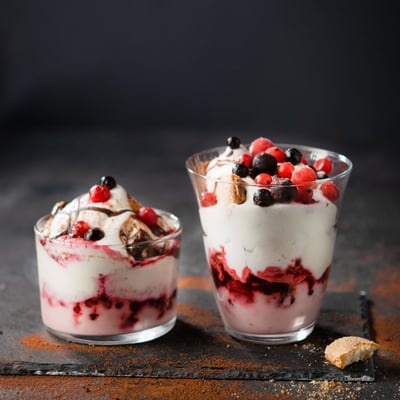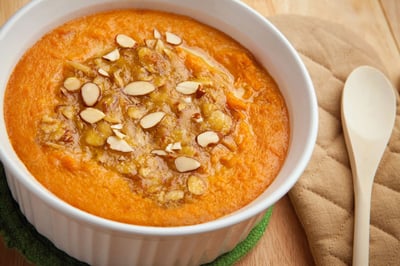Yes, There Are Ways to Eat Dessert Safely with Diabetes
By Constance Brown-Riggs
Just like everyone else, people with diabetes can eat sweets in moderation. Registered dietitian and diabetes educator Constance Brown-Riggs shares her strategies for making dessert part of a healthy diet.
 Many people believe that if you have diabetes, desserts are off-limits. But if you take the right approach, this condition doesn't have to mean deprivation – small amounts of sweets can be included in a healthy diet, even if you have diabetes.
Many people believe that if you have diabetes, desserts are off-limits. But if you take the right approach, this condition doesn't have to mean deprivation – small amounts of sweets can be included in a healthy diet, even if you have diabetes.
As a registered dietitian and certified diabetes care and education specialist, I’m sharing my strategies for enjoying dessert with diabetes. While limiting carbs (and dessert) may help you manage your glucose more easily, this can be a difficult process, so I’m offering suggestions to help you better navigate enjoying sweets.
Start by counting carbs to identify your ideal daily carb intake
If you choose to have dessert, it's a good idea to start with counting carbs. Often people with diabetes find they can better manage their glucose levels if they count how many carbohydrates are in the foods they eat. If you take insulin, counting carbs can also help you determine how much insulin to take before a meal. Many adults with diabetes work with a healthcare professional to determine a carb budget, or how many carbs per meal is right for your body. Some people aim for less than 30 grams of carbohydrate per meal, while others aim as high as 60 grams per meal – though fewer carbs can better help keep blood glucose in range. However, no one-size-fits-all or standard amount of carbohydrate will work for everyone with diabetes. Checking your glucose two hours after eating a meal to see if it’s in range can help you determine what works for your body and how much carbohydrates affect you.
Skip out on other carbs, and keep glucose levels in mind
If you are planning on eating dessert, be sure to keep within your carb budget by eating those sweets instead of other carbohydrates. For instance, you may want to pass on starchy savory options like corn or potatoes, fresh fruit, or even dairy, as milk contains plenty of lactose.
If you've had several days of high glucose readings, it's probably not the best time to have dessert. And on the occasions when you do choose to eat dessert, be careful to limit sweets to one serving per day.
Be careful with reduced-fat desserts
Use caution when choosing reduced-fat, low-fat, or fat-free desserts, and be sure to check the nutrition label. Because fat has been removed to reduce the calorie content in these products, they often contain even more added sugars to heighten their flavor, which means that as a result they often have more total carbohydrates.
My favorite go-tos for diabetes-friendly desserts
The key to creating delicious diabetes-compatible sweets is to start with the right ingredients. Nutrient-rich produce like fresh apples, cranberries, berries, and sweet potatoes can add natural sweetness with a built-in serving of fiber. Other ingredients, like nuts – I love pecans – and yogurt can also be the base of satisfying lower-carb desserts.
Here are some ways I like to use these foods to make dessert part of a healthy diabetes diet.
Apples
 "I thought apples were a high carb fruit that people with diabetes should avoid," you may be thinking. No, you don't have to avoid apples; the key to successfully eating apples is portion control.
"I thought apples were a high carb fruit that people with diabetes should avoid," you may be thinking. No, you don't have to avoid apples; the key to successfully eating apples is portion control.
Apples are packed with nutrients and considered one of nature's sweeteners. One small (4oz) apple has 60 calories and just 15 grams of carbohydrate.
Instead of apple pie with 45 grams of carbs per slice, try a serving of apple crisp with 170 calories, 26 grams of carbohydrate, and 7 grams of fat. To cut back on total carbs, place the apples and other pie ingredients in an individual-sized soufflé dish instead of using pie crust, and then bake and enjoy.
Cranberries
Cranberries are an excellent source of vitamin C and a good source of dietary fiber and vitamin E. They're also a strong source of plant-based compounds that can help prevent urinary tract infections. Instead of cranberry sauce with dinner, save your carbs for a cranberry rice pudding. Don't worry – it won't break your carb budget, with 131 calories, 27 grams of carbohydrate and less than one gram of fat. Rather have cranberries with dinner? Make your own cranberry relish using fresh, whole cranberries instead of canned jellied cranberry sauce, which is loaded with added sugar.
Pumpkin
Pumpkins are loaded with beta-carotene, an important substance found in plants that our bodies convert to Vitamin A. Research indicates that a diet rich in foods containing beta-carotene may help reduce the risk of certain types of cancer and offer protection against heart disease. Instead of a slice of pumpkin pie with 35 grams of carbohydrate, enjoy these wholesome chocolate-chip pumpkin bars with only 15 grams of carbohydrate and 4 grams of fat.If pumpkin pie is on the menu, you can still reduce the calories, fat, and carbs by removing the crust and using egg substitute in place of eggs and evaporated skim milk in place of sweetened condensed milk. And as with any dessert, you can also opt for a smaller portion to help manage carbohydrate and sugar intake.

Sweet Potatoes
Sweet potatoes are brimming with vitamin C, calcium, potassium, and beta-carotene. With a low glycemic index (GI), sweet potatoes raise your glucose slowly, and research suggests they may reduce both hyperglycemia after meals (postprandial) and insulin resistance in people with diabetes. Instead of sweet potato pie, enjoy a spiced sweet potato casserole recipe. You'll be glad you did. It has the same great taste as traditional sweet potato pie with only 10 grams of carbohydrate and 7 grams of fat per serving. If you have no plans to pass up a slice of sweet potato pie, be mindful it will set you back 35 grams of carbohydrates.
Yogurt
 Evidence shows that the intake of milk and milk products, such as yogurt, is associated with a reduced risk of heart disease, type 2 diabetes, and high blood pressure in adults.
Evidence shows that the intake of milk and milk products, such as yogurt, is associated with a reduced risk of heart disease, type 2 diabetes, and high blood pressure in adults.
Most yogurts are also an excellent source of high-quality protein, and regular consumption of yogurt is associated with a more balanced diet.To reduce fat and calories, swap things like butter, heavy cream, or vegetable oil for equal parts of plain yogurt when baking. Replace 1 cup buttermilk with 2/3 cup of plain yogurt.
Many types of yogurt are great additions to your diet if you have diabetes, and there are countless ways to jazz up plain yogurt. Sprinkle it with pecans and cinnamon. If plain yogurt isn't your thing, you can add your favorite sugar substitute, such as stevia.
Instead of strawberry cheesecake, save on carbs and fat with a strawberry cheesecake yogurt parfait, which has 220 calories, 29 grams of carbohydrate and 7 grams of fat.








